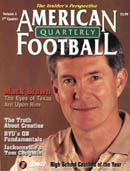AMERICAN FOOTBALL MONTHLY THE #1 RESOURCE FOR FOOTBALL COACHES
Article CategoriesAFM Magazine
|
Clock ManagementGoing Out of Bounds is a Really Big Deal.by: John T. Reed Author, Football Clock Management © More from this issue With 10:10 left in the second quarter at the Cotton Bowl, Texas A&M quarterback Branndon Stewart stepped out of bounds at the line of scrimmage after being flushed out of the pocket on a first-and-ten play. No one thought anything of it. They should have. Stewart's "one small step" for an Aggie turned out to be "one giant leap" for UCLA. It cost Texas A&M the game. I have discovered about 145 principles of clock management-and counting. One of them is that football teams should go to a slowdown in two situations: one, whenever the pace graph or first-and-goal table so indicate, and whenever their win probability is greater than 50 percent. The pace graph is a chart I created for my book Football Clock Management. It applies when you are in your last possession of the first half, regardless of score, and your....The full article can only be seen by subscribers.
|
|
|||||||
| HOME |
MAGAZINE |
SUBSCRIBE | ONLINE COLUMNISTS | COACHING VIDEOS |
Copyright 2026, AmericanFootballMonthly.com
All Rights Reserved





